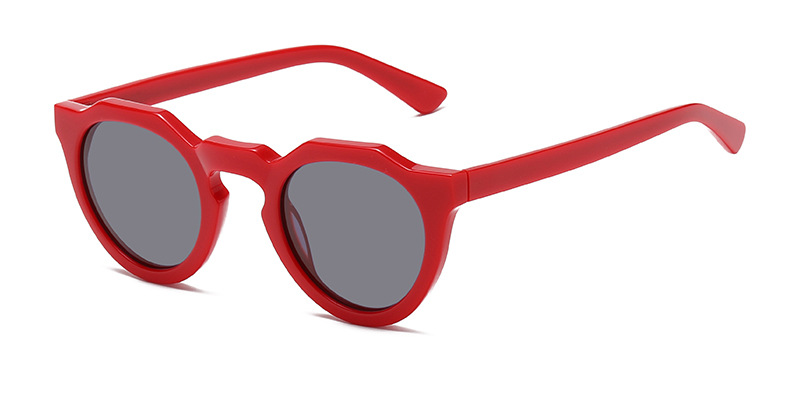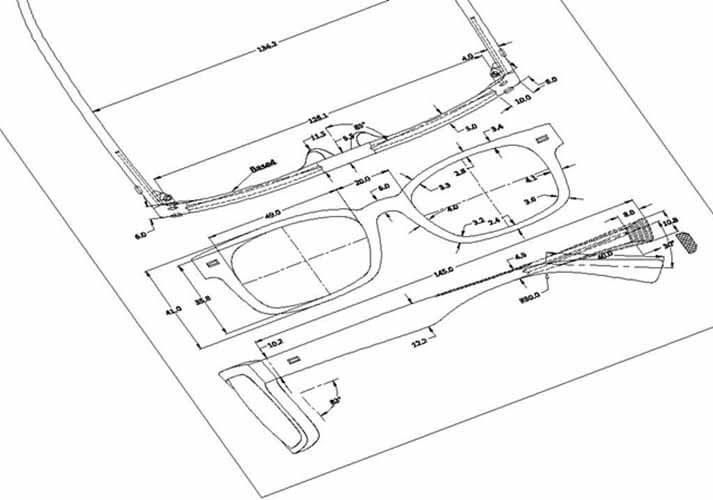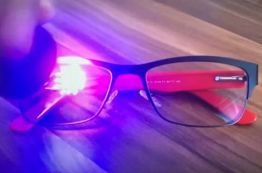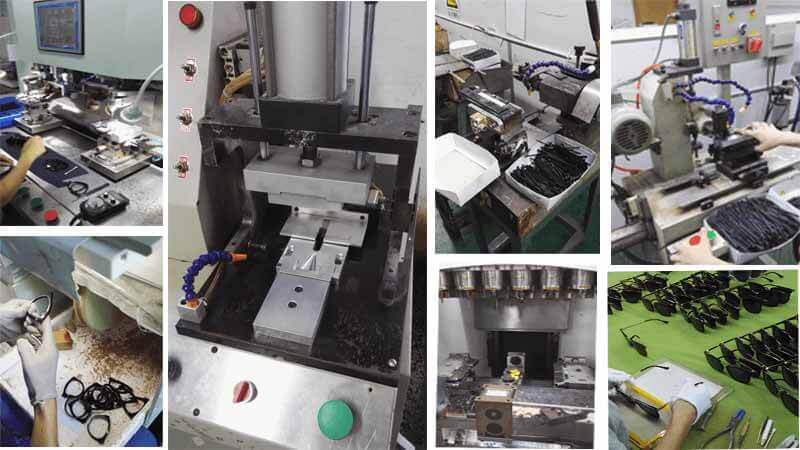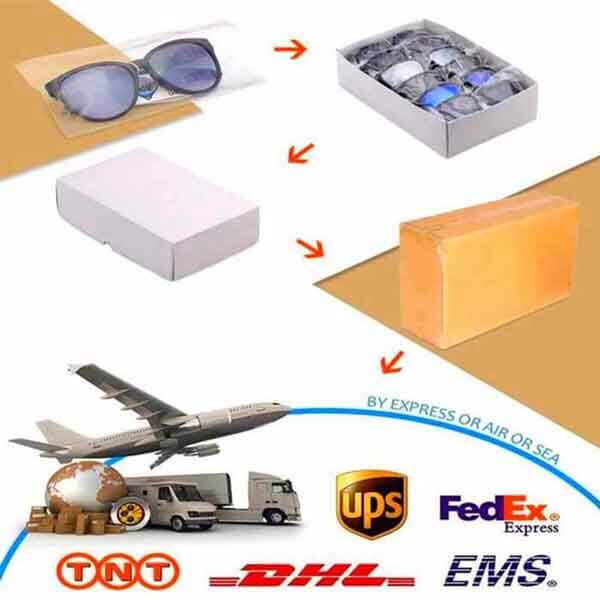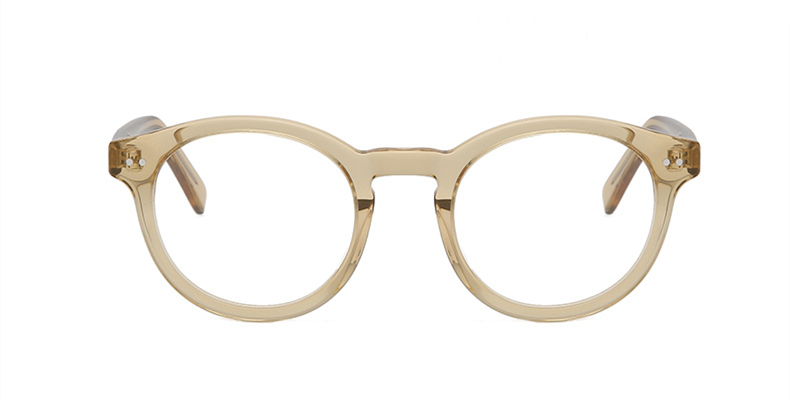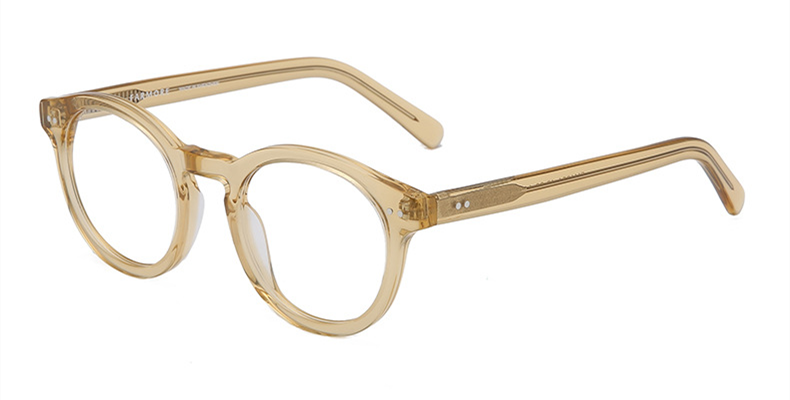Introduction: The Art and Science of Eyewear Manufacturing
Eyewear is not just a tool for vision correction; it has become one of the most important symbols of modern fashion. Eyeglasses not only connect us to the world through visual perception but also serve as symbols of identity and taste. From fashion-forward frames to technologically innovative smart glasses, every pair of eyeglasses is the result of countless hours of wisdom and effort from designers, engineers, and craftsmen.
However, eyewear manufacturing goes far beyond the fusion of design and creativity. It is a complex process that involves multiple precise steps. Each pair of eyeglasses requires meticulous craftsmanship and continuous technological innovation from concept to finished product. From material selection to process optimization, to final quality testing, eyewear manufacturing encompasses the intersection of technology, craftsmanship, and market demand.
Global Eyewear Industry: Scale and Development
The scale of the global eyewear market is astounding. According to data from Grand View Research, the global annual production exceeds 1.5 billion pairs of eyeglasses, with this number expected to continue rising with the growing popularity of smart glasses and customized products. Eyewear is not only an essential part of life but also carries consumers’ deep desires for fashion, individuality, and brand, gradually becoming an expression of lifestyle and aesthetics.
China is the largest eyewear producer in the world, accounting for approximately 50% of the global market. Wenzhou, in particular, has become a central hub of global eyewear manufacturing and a well-known export center. Beyond China, Italy is synonymous with high-end eyewear and occupies a significant position in the global market due to its exquisite craftsmanship, especially in the design and manufacture of luxury eyewear. India and Japan are also important bases for eyewear production, with Gurgaon in India being particularly noted for its efficient production capabilities and cost advantages, attracting global brands.
Global Market Demand: Trends and Diversification
In terms of consumer markets, the United States is one of the largest eyewear consumers globally, with demand diversifying especially with the advent of smart glasses and innovative technologies. Europe and Japan consistently show strong demand in the high-end market, where countries like France, Italy, and Germany prefer luxury eyewear and customized products, driving high-end brand demand in these regions.
Additionally, the rise of emerging markets like China and India has further accelerated the growth of the global eyewear industry. These markets are increasingly demanding fashionable eyewear, personalized designs, and products with smart features, prompting eyewear manufacturers to push boundaries in both innovation and technology.
Challenges and Opportunities: A Continuously Evolving Industry
With technological advancements and evolving consumer demands, the eyewear industry is undergoing unprecedented transformation. From 3D printing to smart glasses, and the use of sustainable materials, eyewear manufacturing is becoming more personalized, intelligent, and eco-friendly. This not only presents challenges for eyewear manufacturers but also provides vast opportunities for innovation.
This article will delve into the various stages of eyewear production, revealing the technology and craftsmanship behind it, as well as how continuous innovation helps meet the growing market demands. Through data and real-life case studies, we will explore the world of eyewear manufacturing, understand its essence, and uncover the trends shaping its future.
1. Eyewear Manufacturing Basics: Concepts and Design
Design Concepts and Market Research: Tapping into Trends
Before the creation of any successful eyewear, designers must dive deep into the market to understand the needs of every consumer. According to Statista’s 2023 report, the global eyewear market is expected to reach $188 billion by 2027, with a compound annual growth rate (CAGR) of 5.7%. This growth reflects consumers’ high focus on personalization, comfort, and style.
Especially according to Grand View Research, the global smart eyewear market is also experiencing rapid growth, with the market size expected to exceed $20 billion by 2025. This means designers must not only focus on the functionality and appearance of traditional eyewear but also integrate future technologies such as Augmented Reality (AR) and Virtual Reality (VR) into eyewear designs to meet the needs of future consumers.
Personnel Requirements and Professional Background
During this stage, the design team typically consists of 3 to 5 designers who need backgrounds in industrial design, fashion design, and market analysis. Each designer usually requires at least 2 to 5 years of design experience, with proficiency in CAD software and user experience design to strike the right balance between creativity and functionality.
Time Estimate: The market research and initial design concept stage typically takes about 3 to 6 months. During this period, designers and brand managers work intensively, striving to capture shifts in consumer psychology.
Design Process: From Sketches to Digital Magic
Once market research is completed, designers start sketching out the initial drafts. Each stroke carries their understanding of aesthetics and functionality. After completing the first draft, designers enter the digital modeling phase, using CAD (Computer-Aided Design) software to turn hand-drawn sketches into precise 3D models.
Using software such as Rhinoceros or AutoCAD, designers can precisely adjust the frame’s dimensions, curves, and even the thickness of the lenses. According to the American Optometric Association (AOA), eyewear designs not only need to be comfortable but also support visual health by ensuring proper lens curvature and nose pad design to reduce eye fatigue and improve wearers’ visual clarity.
Personnel Requirements and Professional Background:
The digital design phase typically requires 2 to 3 specialized designers who need expertise in CAD design and 3D modeling. They should be proficient in at least one commonly used design software, such as Rhinoceros or SolidWorks, and typically have more than 3 years of industry experience.
Time Estimate: This CAD design phase usually takes 2 to 4 weeks, with the digital model likely undergoing several revisions and adjustments depending on the design complexity until it’s perfected.
Material Selection and Technological Innovation: The Birth of the Perfect Frame
The choice of material is akin to an architect selecting the raw materials for constructing a house. Every material has its unique advantages and limitations. Eyewear designers typically work closely with materials scientists to carefully choose materials that ensure the final product achieves a perfect balance between aesthetics, comfort, and durability.
For example, acetate is often used for fashionable eyewear because of its rich colors and moldability. Designers can select and create multiple frames in different colors and styles within just 1 to 2 weeks. For those who prefer lightweight yet durable designs, titanium alloys are the best choice. The manufacturing cycle for titanium typically takes 3 to 4 weeks, with laser cutting and welding technologies ensuring that every frame is both light and sturdy.
According to a report from the Materials Research and Technology Development Center (MatWeb), the use of titanium alloys and other advanced metal materials in eyewear production has been increasing year by year. Especially in the high-end market, the usage of titanium alloys, aluminum alloys, and stainless steel has risen significantly. Titanium alloys, known for their superior corrosion resistance and excellent mechanical properties, have become the material of choice for many high-end eyewear frames.
Personnel Requirements and Professional Background:
At this stage, 1 to 2 materials engineers are typically needed to analyze and select the appropriate materials. These engineers generally require a background in materials science or chemical engineering, with at least 3 years of experience in material research.
2. Prototype Creation and Initial Production: From Digital to Physical
From Digital to Tangible: Turning Designs into Touchable Art
Once the design drawings are complete, the next step is to transform the digital model into a physical object. Traditionally, manufacturers would create molds to produce prototypes, but today, 3D printing technology has revolutionized this process. According to the latest report from Wohlers Associates, the global additive manufacturing market reached $10 billion in 2019, with 3D printing playing a significant role in industrial design applications.
Designers can use 3D printing to directly convert design drawings into real prototypes. This process not only saves a considerable amount of time but also allows designers to make quick adjustments and optimizations. A study by McKinsey & Company found that the widespread adoption of 3D printing is reducing product prototype production cycles from the traditional 6 to 8 weeks to just 1 to 2 weeks, significantly boosting production efficiency.
Personnel Requirements and Professional Background
Prototype creation typically requires 2 3D printing engineers who must have expertise in 3D modeling and additive manufacturing technologies. They should be proficient in operating 3D printers and making prototype adjustments. Typically, these engineers should have 1 to 3 years of experience in 3D printing or prototype creation.
Time Estimate:
3D printing prototypes usually take just 2 to 3 days, much more efficient than the several weeks needed for traditional mold production.
Prototype Testing and Improvement: Every Detail Matters
After the prototype is created, the next task is testing. At this stage, designers wear the prototypes to assess comfort, the length of the temple arms, and the fit of the nose pads. Through repeated testing, designers identify small but crucial issues, such as overly tight temples or insufficient curvature in the lenses. Based on this feedback, they continue to make adjustments until the most ideal design is achieved.
According to research by the American Academy of Optometry, comfort testing is a critical part of eyewear design because wearing ill-fitting frames for long periods can lead to eye fatigue or headaches. Therefore, optimizing the prototype during the testing phase is vital.
Personnel Requirements and Professional Background
The testing team typically consists of 1 to 2 ergonomics experts and 1 quality control expert, who need to have knowledge in ergonomics and product testing to evaluate the comfort and performance of the eyewear.
Time Estimate:
This phase of prototype testing and revisions typically takes 4 weeks, with each improvement enhancing the eyewear’s comfort and functionality.
3. Manufacturing Process: The Fine Craftsmanship of Eyewear Frames and Lenses
Eyewear Frame Manufacturing Process: Every Detail Pursued for Perfection
Once the prototype design is completed and approved, the manufacturing phase begins. The production of eyewear frames uses various advanced techniques depending on the material. Plastic frames typically undergo injection molding, a process where heated plastic pellets are injected into molds to rapidly form the frame. Metal frames, on the other hand, rely on laser cutting and welding techniques to ensure precise craftsmanship, resulting in frames with both high strength and aesthetic appeal.
Machinery and Equipment
- Injection Molding Machine: Used for molding plastic frames. This equipment injects heated plastic pellets into pre-designed molds, forming the basic shape of the frame after cooling and setting.
- Laser Cutting Machine: Used for precise cutting of metal frames. The laser cutting machine uses high-energy laser beams to accurately cut metal sheets, ensuring the perfect dimensions and shape of the frame.
- Welding Machine: Used to weld metal frames together, ensuring that the temples and front frames are securely joined.
Support Data:
- European Union’s Ecodesign Directive mandates eyewear manufacturers to adhere to environmental standards regarding material selection and production processes. These regulations are designed to reduce environmental impacts during production.s
- Many eyewear brands have adopted more eco-friendly bioplastics or recyclable metals, reducing carbon footprints. According to industry data, recyclable metals can reduce the carbon footprint of production by up to 30% compared to traditional materials.
Personnel Requirements and Professional Background
The eyewear frame manufacturing process typically requires 5 to 8 skilled workers, including injection molding engineers, laser cutting experts, and welding technicians. These workers usually have backgrounds in mechanical engineering, materials science, or industrial design, and are proficient in the relevant manufacturing processes.
Time Estimation:
The production of each eyewear frame typically takes 3 to 5 days, depending on the material. This includes steps such as injection molding for plastic frames or laser cutting, welding, and polishing for metal frames. A detailed study of eyewear production time shows that metal frames take an average of 1.5 days longer to produce than plastic frames due to the complexity of the laser cutting and welding processes.
Lens Manufacturing: Detailed and Ingeniously Crafted
Lens production is equally critical. The lens manufacturing process starts with material cutting, where the lenses are cut to the required shape and size based on the dimensions of the eyewear frame. Next, the lenses undergo polishing, coating (such as UV protection, blue light protection, and anti-reflective coatings), and other steps to ensure they have the necessary durability and optical performance.
Machinery and Equipment:
- Lens Cutting Machine: This equipment cuts lens material into the required shape and size. The cutting machine operates with high-precision blades to ensure accurate cuts.
- Polishing Machine: Used for polishing the lens surface, making it smooth and shiny, reducing visual distortion and improving comfort.
- Coating Machine: Used to apply special coatings such as UV protection, blue light protection, and anti-reflective coatings to the lens surface. These coatings enhance the durability and optical performance of the lenses.
Support Data:
- According to the American National Standards Institute (ANSI), lens quality control is crucial, especially regarding optical performance and durability. Every lens must meet specific standards, such as:
- Light transmission: Lenses must allow at least 90% of light to pass through.
- UV protection: Lenses must block 99-100% of harmful UV rays.
- Scratch resistance: Lenses must undergo testing to ensure anti-scratch coatings meet the necessary durability standards.
Personnel Requirements and Professional Background
Lens production requires 3 to 5 workers, including optical engineers and coating specialists. These professionals typically have backgrounds in optical engineering, materials science, or surface treatment technologies, and at least 2 to 3 years of related experience.
Time Estimation:
The cutting, polishing, and coating processes for lenses usually take 2 to 4 days, depending on the lens thickness, the complexity of the coatings, and whether any custom treatments are needed. Custom coatings can add up to 1 extra day to the production time, based on their complexity.
4. Quality Control: Ensuring a Flawless Product
Eyewear Quality Control: Comprehensive Inspection from Details to Overall Performance
Quality control spans the entire production process, from raw material inspection to final product testing. Each step is crucial. During production, quality control personnel conduct thorough inspections based on industry standards (such as ISO 12870) to ensure that each pair of eyewear meets durability, comfort, and visual clarity requirements.
Machinery and Equipment
- Optical Testing Instruments: Used to test the optical performance of lenses, including light transmittance, reflectivity, refractive index, and more.
- Scratch Resistance Tester: Used to test the scratch resistance of lens coatings to ensure that the lenses maintain long-lasting clarity during use.
- Frame Strength Tester: Used to test the durability and compression strength of frames to ensure that the eyewear frames do not deform or break during daily use.
- Nose Pad and Temple Fit Test Equipment: Used to check the comfort and fit of nose pads and temples to ensure the wearer remains comfortable during long-term wear.
In accordance with ISO 9001:2015 Quality Management System standards, all produced eyewear products must undergo rigorous performance testing. These tests include pressure resistance tests, heat resistance tests, lens scratch resistance tests, and nose pad comfort tests. These steps ensure the comfort, safety, and durability of eyewear in daily use, with secure and durable lens-frame connections.
Personnel Requirements and Professional Background
The quality control team typically consists of 2 to 3 quality engineers who should have backgrounds in quality management, industrial engineering, or optical testing, and be familiar with using quality inspection instruments and tools.
Time Estimate:
Quality control typically takes 3 to 5 days, during which all eyewear produced undergoes strict testing to ensure flawless comfort, functionality, and durability.
5. Final Assembly and Packaging: Preparing for the Market
Eyewear Assembly: Precision Craftsmanship
In the final assembly phase, technicians combine the lenses with the frames. Whether the frame is plastic or metal, the assembly process must be delicate and precise. Each pair of glasses requires adjustments to the angle of the temples for the wearer’s comfort, and the nose pads must be finely tuned to ensure there is no discomfort during wear.
Machine Equipment:
- Assembly Fixtures: These fixtures are used to secure the eyeglass frames, allowing workers to perform the assembly process with greater precision. They help workers quickly adjust the frame to ensure the lenses and the frame are perfectly aligned.
- Automated Assembly Line: In high-end eyewear production, automated assembly lines are widely used. These machines can achieve more precise assembly than manual labor, improving production efficiency.
Support Data:
According to data from the Vision Council, comfort is crucial to consumer satisfaction when it comes to eyewear. Over 70% of consumers worldwide say that comfort is one of the top factors when purchasing glasses. This emphasizes the importance of precision and careful adjustment during the assembly process to meet consumer expectations.
Personnel Requirements and Professional Background
This phase typically requires 3 to 5 assembly workers who should have experience in fine assembly and electronic assembly, with a strong grasp of connecting lenses and frames. At least 1 year of relevant experience is usually required.
Time Estimate:
The assembly time for each pair of glasses typically ranges from 5 to 10 minutes. Custom high-end glasses may require more time to ensure every detail is flawless.
Packaging and Shipping: Protection and Display
Eyewear packaging is not only for protection but also serves as a brand statement. High-end brands often opt for exquisite packaging, including custom cases, cleaning cloths, and brand cards, to enhance the consumer experience and brand recognition.
Machine Equipment
- Packaging Conveyor Line: This equipment is used for automated packaging, allowing glasses to be quickly packed and distributed to various order areas. It can also inspect the appearance of the packaging to ensure its aesthetics and completeness.
- Heat Sealing Machine: Used to seal the eyewear cases, ensuring the glasses inside are not damaged during transportation.
Support Data:
According to a report by Packaging Digest, high-end eyewear brands often invest in packaging as much as the product itself. Beautiful packaging not only enhances the brand image but also increases consumer desire to purchase. The careful packaging process ensures the safety of each pair of glasses, preventing damage during transport.
Personnel Requirements and Professional Background
The packaging team typically consists of 2 workers who should have experience in logistics management or product packaging. They must ensure each pair of glasses is safely and elegantly displayed.
Time Estimate:
Packaging each pair of glasses typically takes 1 to 2 minutes, although the time may be extended for custom packaging.
6. Continuous Innovation and Challenges: Staying Ahead of the Times
As consumers increasingly demand personalized and customized products, eyewear manufacturers are facing unprecedented challenges. According to a report by Deloitte, more than 50% of global consumers stated they are willing to pay more for customized products. In this context, eyewear manufacturers must seek innovative solutions to maintain production efficiency while offering more personalized and differentiated products.
Smart Glasses: Merging Technology and Design
Smart glasses are gradually becoming the core of the eyewear industry’s future. According to a forecast by Gartner, the global smart glasses market will reach $20 billion by 2027, with eyewear integrated with augmented reality (AR) and virtual reality (VR) being the most popular choice among consumers. To meet this demand, eyewear manufacturers will need to incorporate higher-tech hardware integration alongside traditional eyewear manufacturing processes.
Personnel Requirements and Professional Background
The team developing smart glasses must include hardware engineers, software developers, data analysts, and user interface designers. The entire team should have 5 to 8 years of experience and be capable of effectively integrating high-tech elements into eyewear design.

